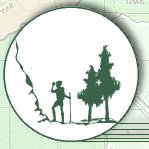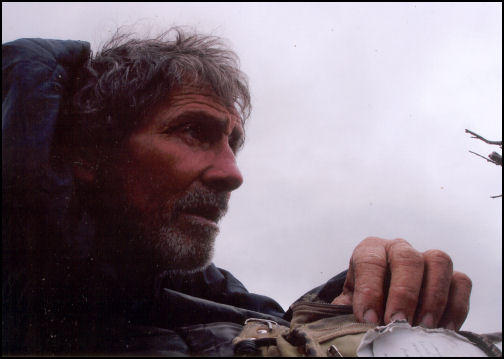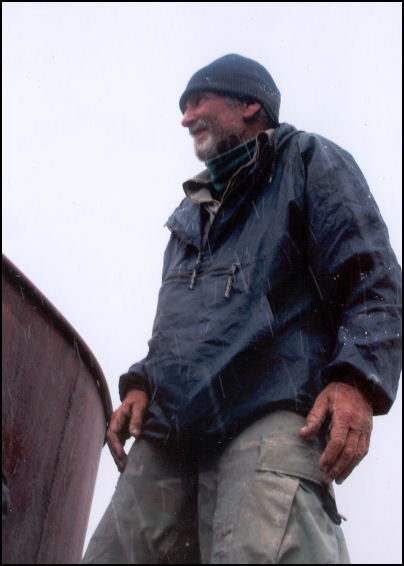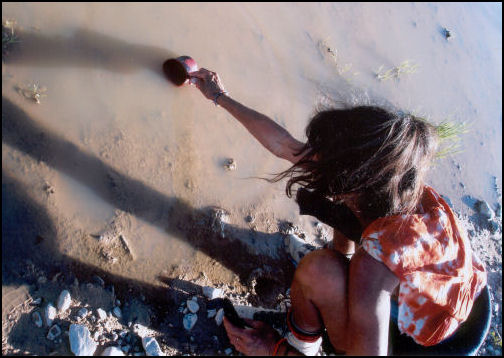
 |
 |
 |
 |
 |
 |
 |
 |
 |
|
In HARM’S way
BY
STUART KELLOGG For
years, Lee Bergthold has been intrigued by the snowbound
Donner party, only 47 of whose 82 members survived the winter
of 1846-47, despite resorting to cannibalism. The
question that sends Bergthold, founder/director of the Center
for Wilderness Studies, on 35-day, 350-mile treks through the
desert is this: Could
the pioneers have saved themselves if, instead of trying to
climb the Sierra Nevada so late in the season, they had
traveled south toward Death Valley and then headed west to Big
Pine? The
Donner part were as much the victims of belief, disbelief and
impatience as they were of starvation. In
the mid-19th century the typical route to
California, known as the California Trail, began in
Independence, MO,
and followed the Oregon Trail to Fort Hall (near present day
Pocatello, Idaho). Here
it diverged, following the Humboldt River in what is now
Nevada and ending at Sutter’s Fort near Sacramento. Un
1845, the real-estate promoter Lansford Hastings published
“The Emigrant’s Guide to Oregon and California.”
According to Hastings: “The
most direct route, for the California emigrants, would be to
leave the Oregon route, about two hundred miles east from Fort
Hall; thence bearing West Southwest, to the Salt Lake; and
thence continuing down to the bay of St. Francisco.” Hastings
had never tested his recommendations, but a party of settlers
from Springfield, IL – led by George and Jacob Donner –
believed Hasting’s boast that the cutoff could save them 350
miles. Instead,
Hastings’ “shortcut” across wet desert sand bogged down
the Donners wagons, adding three weeks to their trek and
casing them to arrive at the foot of the Sierras just before
an unusually early snowstorm hit. The
Indian Chief Truckee warned them to wait until the spring thaw
before attempting the pass, but they were impatient to reach
California – and ignored the chief’s advice. To
test his theory that a southerly route was feasible, in the
winter of 1996-97 Bergthold – an assistant professor of
photography at Antelope Valley College, in Lancaster –
walked with Christine Bowers, a free-lance photojournalist,
from Battle Mountain, Nev. (190 miles northeast of Lake Tahoe)
to Death Valley.
Enduring wind chills of minus 20◦ F, Bergthold lost
three toenails to frostbite and 22 pounds.
Bowers shed 10 pounds and nearly lost her life. But
Bergthold, a former Marine Survival instructor, says he was
convinced that “the Donners could have followed a more
southerly route to the northern boundary of Death Valley, cut
west over Westgard Pass, wintered in the Owens Valley and then
crossed the Sierras come summer. Gluttons
for punishment, Bergthold and Bowers made a second trip three
years later, accompanied by Al Caler.
This time they trekked from Death Valley to the north shore of
the Salton Sea, a journey of 34 days and 350 miles. At
one point, the three were down to half a cup of water each. If
you have inadequate water, Bergthold says, you suspend eating.
The digestion process draws water from your body, so
the more you eat, the thirstier you are. Bowers
lost 15 pounds, Bergthold 22 and Caler even more. According
to Bergthold, there were trails connecting the spot where the
Salton Sea is now and San Luis Obispo, so the Donners could
conceivably have made their way to the ocean. But
he has decided the Donners should not have tried this route.
Not only was there insufficient water, but having
headed so far southeast, they would have lost whatever headway
they’d gained. “Our
second hike was really just a test of endurance,” Bergthold
says. This
spring, Bergthold, Bowers, Caler and Connie Simpkins completed
the third lap of their grueling experiment.
Following the Hastings cutoff, they walked from near
Donner Springs at the Utah/Nevada border, to Battle Mountain
in Nevada, a journey of 32 days and 300 miles. Each
of the trekkers lost between 12 and 15 pounds. The
19th century pioneers traveled with wagons and
stock – a minus because they had to feed and water their
animals. But
this was also a plus because they didn’t have to carry
supplies on their own backs and the wagons allowed them to
haul vats of water. To
simulate pioneer conditions as closely as possible, during all
three adventures Bergthold’s groups set out carrying their
gear, a 10-day supply of food and some water. At
approximately 10-day intervals, they would find food dropped
off by support personnel, who otherwise kept at a distance. “In
between drop-off points,” Bergthold says, “someone would
bring us water – if they could find us.” Otherwise
they depended on groundwater, snow, frost, creeks and rivers. “After
dark,” Bergthold claims, “I can smell water.
I’m smelling the roots through which the moisture is
rising up into a plant. Animal
tracks or bugs are also good signs of water, though an
animal’s carcass will have poisoned the supply. Like
the pilot of an airplane, who must know the point of no
return, Berthold never goes farther than five or eight miles
from a known water supply. “But
I have rarely had to return to a source,” he says.
“And even though I only occasionally treat water with
NutriBiotic, a grapefruit-seed extract, I’ve never
experienced giardia or cryptosporidiosis. “Because
giardia and cryptosporidiosis sink to the bottom, you can get
fairly clear water from the top of a puddle of still
groundwater. Likewise,
it’s better to take water from a quiet stream rather than a
frothy one – even though you may think that frothy water
will be better aerated.” At
the prescribed points, the trekkers at apples, oranges,
bananas, peanut butter and cookies for calories.
And because one requires oils in cold weather, in their
backpacks they carried such foods as sardines, tuna and
oysters. It
worries Bergthold that motorized vehicles like ATV’s and
four-wheelers take inexperienced people far into the back
country – and break down there. In
June of 1995, Eric Knight, 32 of Long Beach, went rock hunting
in the desert without telling anyone where he was going. After
his four-wheel drive Jeep Comanche became buried up to the
hubs in soft sand, Knight set off for Ludlow, first on a bike,
later on foot. Three
days later, his body was found half a mile from Ludlow. According
to the article published June 21, 1997, in the Desert
Dispatch, Knight’s parents were so impressed with efforts of
the San Bernardino County Sheriff’s Department Search and
Rescue Team, they paid for the publication of “Desert Travel
Hints.” Among
its many tips, the pamphlet recommends:
In
his introduction to “Deserts” (Alfred A. Knopf, 1985),
James A. MacMahon adds these hints:
“True
desert people know to carry water and tools,” says
Bergthold. But for
his two-footed treks, he makes sure to bring spare boot laces.
ADDRESS: c/o Lee
Bergthold, 41331 20th St West, Palmdale, CA
93551 PHONE: (661) 947-5153 EMAIL: avcws@yahoo.com WEB SITE: avcws.tripod.com Daily
Press, Victorville, CA |
|
 |
|


